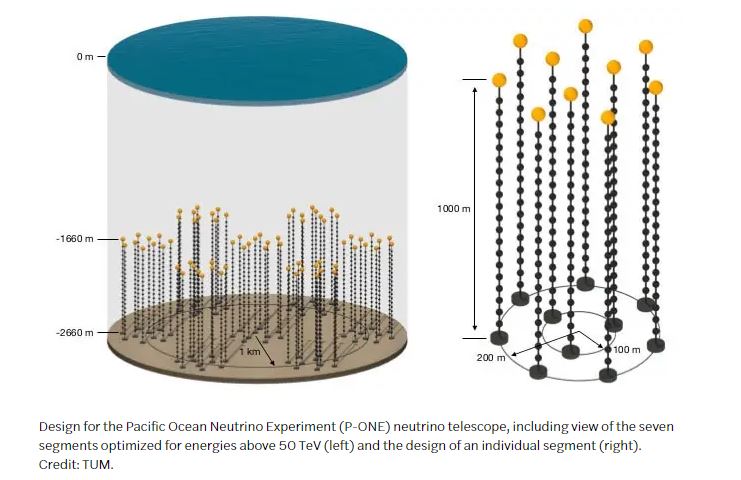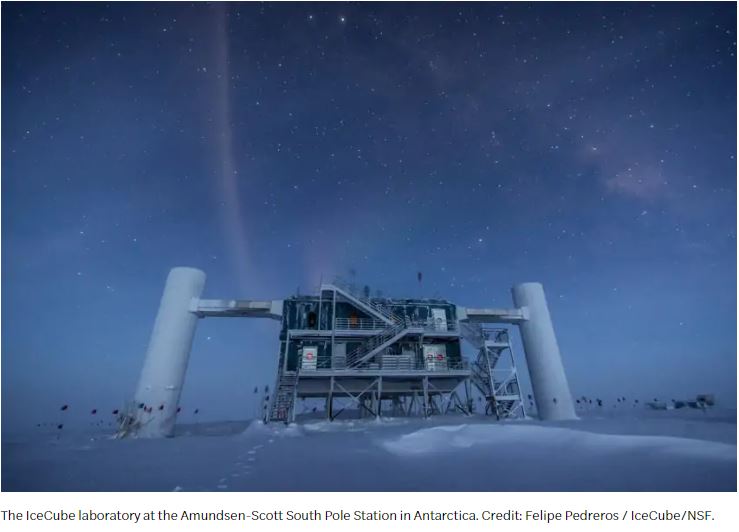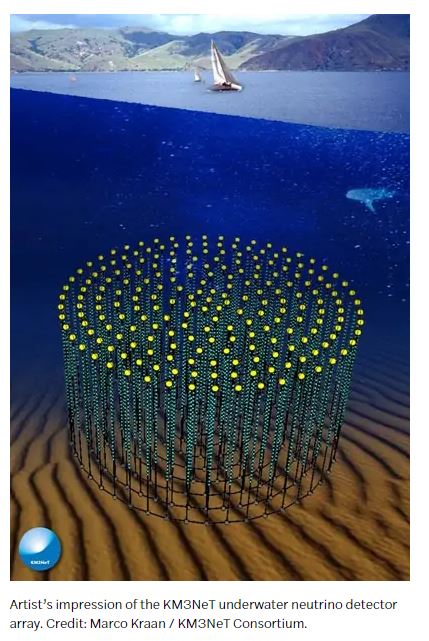Illustration of several optical modules from the Pacific Ocean Neutrino Observatory (P-ONE) underwater neutrino telescope. Credit: TUM (modules) / Marc Blazewicz (illustration).
There are plans for three subsea neutrino detector observatories. What seems to be a tough and hazardous operation has enormous cosmic repercussions.
Light has always been employed in astronomy to explore distant celestial objects. However, photons aren’t the only particles that make it to humans. Because neutrinos aren’t deflected or hampered, they’re also useful for investigating the cosmos, particularly at its extremes.
They’re small, practically massless, and omnipresent – the Sun’s nuclear fusion processes, for example, are continually producing them. Approximately 60 billion neutrinos travel past your thumbnail per second if you raise your hand, like little ghosts.
According to astrophysicists, they aren’t the most fascinating kind of neutrinos. They’d rather examine super-fast, super-energetic neutrinos that have traveled a long distance. And it turns out that spotting them is really tough.
That is why scientists want to construct a neutrino telescope more than two kilometers under the Pacific Ocean’s surface.
Every second, nearly 60 billion neutrinos travel through your thumbnail if you raise your hand.
“Neutrino telescopes are a technical miracle,” says project leader and astronomer Elisa Resconi of the Technical University of Munich in Germany.
“In a neutrino telescope, we measure the faintest light possible, with the shortest time synchronizations conceivable, with the least amount of power usage and the most data.” All of this from the furthest reaches of the globe.”
She claims that a prototype of the telescope, dubbed P-ONE (Pacific Ocean Neutrino Experiment), would be completed by the end of next year.
So here’s how it’ll work: Seventy one-kilometer-long strings will be plunged deep into the darkness just off the coast of British Columbia in the north-east Pacific Ocean. The floats will be tied to the strings, which will be studded with sensitive light detectors and will stand erect like kelp.
Then they’ll wait and watch for radiation flashes that occur when near-massless subatomic particles collide in the water.
The telescope will specifically seek for high-energy neutrinos that have traveled from far outside the cosmos and were created in unusual events like as supernovae, gamma ray bursts, or colliding stars.
“We can examine processes and locations that are shrouded in photons – we can research beyond any thick cloud or accretion disk,” Resconi explains.
Astrophysicists may use these messages from the stars to explore areas like the dust-encrusted center of our Milky Way Galaxy, or look for evidence of cosmic ray production or even dark matter.
“Of course, we could uncover something we can’t conceive right now,” Resconi says. “We only comprehend a tiny portion of the cosmos.”
Neutrino telescopes are incredible technological achievements.”
Elisa Resconi, Munich Technical University
The IceCube Neutrino Observatory is presently the only telescope sensitive enough to detect these high-energy neutrinos. Since 2011, it has been working in Antarctica, with detectors dug into a cubic kilometer of pure ice.
IceCube discovered the first high-energy astrophysical neutrinos, as well as evidence that some of these particles originate from blazars, which are very active galaxies fueled by a large black hole.
However, it has only discovered a few astrophysical neutrinos in total.
“While this improvement is encouraging,” Resconi adds, “it also demonstrates that the neutrino sample obtained from the universe is still too small to move on this promising, rich route of fundamental discoveries in astro- and particle physics with a telescope just the size of a cubic kilometer.”
P-ONE will have the best chance of detecting these tremendously energetic particles with a total of 1400 detectors across three cubic kilometers. Because it’s bigger than IceCube, it should be able to locate rarer and higher-energy occurrences.
This isn’t the first or only effort to construct a water-based neutrino telescope. Others, such as the Cubic Kilometre Neutrino Telescope (KM3NeT) in the Mediterranean and the Baikal Deep Underwater Neutrino Telescope (Baikal-GVD) in a frozen lake in Siberia, are now under development.
Clancy James, a member of the KM3NeT collaboration, believes that the more observatories hunting for neutrinos, the better.
“Neutrino astronomy is still in its early stages,” James, who works at the Curtin Institute of Radio Astronomy in Perth, Western Australia, adds. “The more people that attempt to find these elusive particles, the more innovative ideas, better technical solutions, and sheer statistical power we’ll have to comprehend them.”
Why did you select the sea?
Sure, 60 billion neutrinos travel past your fingernail every second, but they seldom interact with anything else. Only one neutrino will interact with your body throughout your lifetime.
To observe neutrinos, you need “a large volume of optically transparent material in a very dark environment – therefore at a fundamental level, both the ocean and Antarctic ice work well,” according to James.
Because the detectors are looking for flashes of Cherenkov radiation, which neutrinos emit when they contact with a water or ice molecule, the area must be dark. The detectors can precisely follow the journey of the neutrino from that flash to determine where it originated from, how much energy it had, and even how it produced.
However, there are several major distinctions between developing a detector in water and ice, according to James.
The construction of a detector in water and ice differs significantly.
“Water, for example, scatters light less, so you can get a better notion of where neutrinos originate from – but it absorbs light more, so you have less light to deal with,” he explains.
P-ONE also has a significant advantage over ice in that it will use existing oceanographic infrastructure off the coast of Vancouver Island. This network, which was built and is administered by Oceans Networks Canada (ONC), a research center at the University of Victoria in Canada, is the world’s largest.
According to Resconi, the infrastructure consists of an 800-kilometer fiber optical cable loop 2.6 kilometers below the surface. This is already linked to the shore for power and data transfer to and from the underwater equipment.
She also points out that no earlier efforts to construct telescopes under water have used existing infrastructure, resulting in substantially higher startup costs.
“I think we’ve found a new set of optimum neutrino telescope settings.”
The deep ocean, on the other hand, has its own set of difficulties.
“Of course, currents are a concern, since they cause the kilometer-long instrumented cables to shift,” Resconi explains.
Because rigorously constructing such lengthy lines would be expensive and logistically difficult, the best answer is to let them drift freely while keeping a close eye on them.
“To overcome this difficulty, we’re altering the buoys on top and putting an optical monitoring system that will continually identify where the modules are relative to each other,” she explains. “We think that by using these two strategies, we will be able to keep the telescope’s geometry under control at the 10–20cm level.”
Astronomers require this precision because they wish to reconstruct a neutrino’s passage back to its cosmic origin, and if you don’t know where your detector is, this extrapolation might be messed up.
“Each detector line is rolled into a ball, weighted with concrete, and dropped from a ship — only in extremely calm weather!”
Curtin Institute of Radio Astronomy’s Clancy James
Even before you get to that stage, deploying the telescope is difficult since it’s tilted over the side of a ship.
KM3NeT is deployed in the following way, according to James: “Each detector line is rolled into a ball, weighted with concrete, and dropped from a ship — only in extremely calm weather!” It goes to the bottom with a precision of a few meters.
“After that, an auditory signal is delivered, and a clip is released.” The detectors unwind upwards due to their buoyancy (the glass spheres housing the optical sensors also contain vacuum).
“An underwater autonomous robotic sub will be required later to link the power and electrical cables from the line’s base to an underwater hub.”
Keep an eye on the detection units that are being deployed for KM3NeT:
It’s all about the setting
According to Resconi, the location in the Pacific Ocean will also benefit neutrino astronomers.
“The neutrino sky that we can investigate from the north-east Pacific will be complimentary to IceCube’s neutrino sky,” she adds. “A neutrino telescope views through the Earth, so the sky it sees corresponds to the hemisphere on the other side.”
Because neutrinos seldom interact with anything, they’re the only particles known to make it all the way into the Earth’s atmosphere.
“IceCube observes the northern sky, while a neutrino telescope in the north studies the southern sky,” explains Resconi.
This is great news, since the southern hemisphere sky is the greatest for seeing the center of our galaxy and studying probable neutrino sources.
In the northern hemisphere, KM3NeT and GVD are also being created. While their data will be identical to P- ONE’s, the telescopes will not be competing directly.
A neutrino telescope views through the Earth, so the sky it sees corresponds to the hemisphere on the other side.
Elisa Resconi, Munich Technical University
James says that data from P-ONE could help the KM3NeT team achieve one of their main science goals: to discover the sources of cosmic rays in our galaxy.
“Cosmic rays are high-energy particles bombarding the Earth from space, with energies up to ten million times what can be produced on Earth in the Large Hadron Collider,” he explains. “But we don’t know where they come from.”
They could have been jettisoned out of supernova explosions, forming neutrinos when they collide with interstellar gas.
“The problem,” James says, “is that these neutrinos interact very rarely, and detecting them from the relatively weak sources in our galaxy will be much more difficult than detecting them from the supermassive black holes spewing out huge jets of gas in more distant galaxies. So using data from P-ONE together with data from KM3NeT and GVD will be a big plus.”
So, what’s up next?
The P-ONE team is presently in the prototype phase, with the goal of developing and deploying three detector lines out of a total of 70.
“The prototype phase is quite interesting: the community has a lot of learned lessons from IceCube and KM3NeT,” explains Resconi. “Technology has also progressed significantly. We’ve found some solid industrial partners, and we’re hoping to work with oceanographers to create synergies and assist us as much as possible in our research of the changing ocean.”
Mass manufacturing will be the next step. By the end of the decade, the best-case scenario is to have a telescope comparable to IceCube, and then maybe grow from there.
Furthermore, the scale of an ocean-based neutrino detector is only limited by finance.
“We want to go large,” Resconi adds, “and we have the infrastructure in place.”






